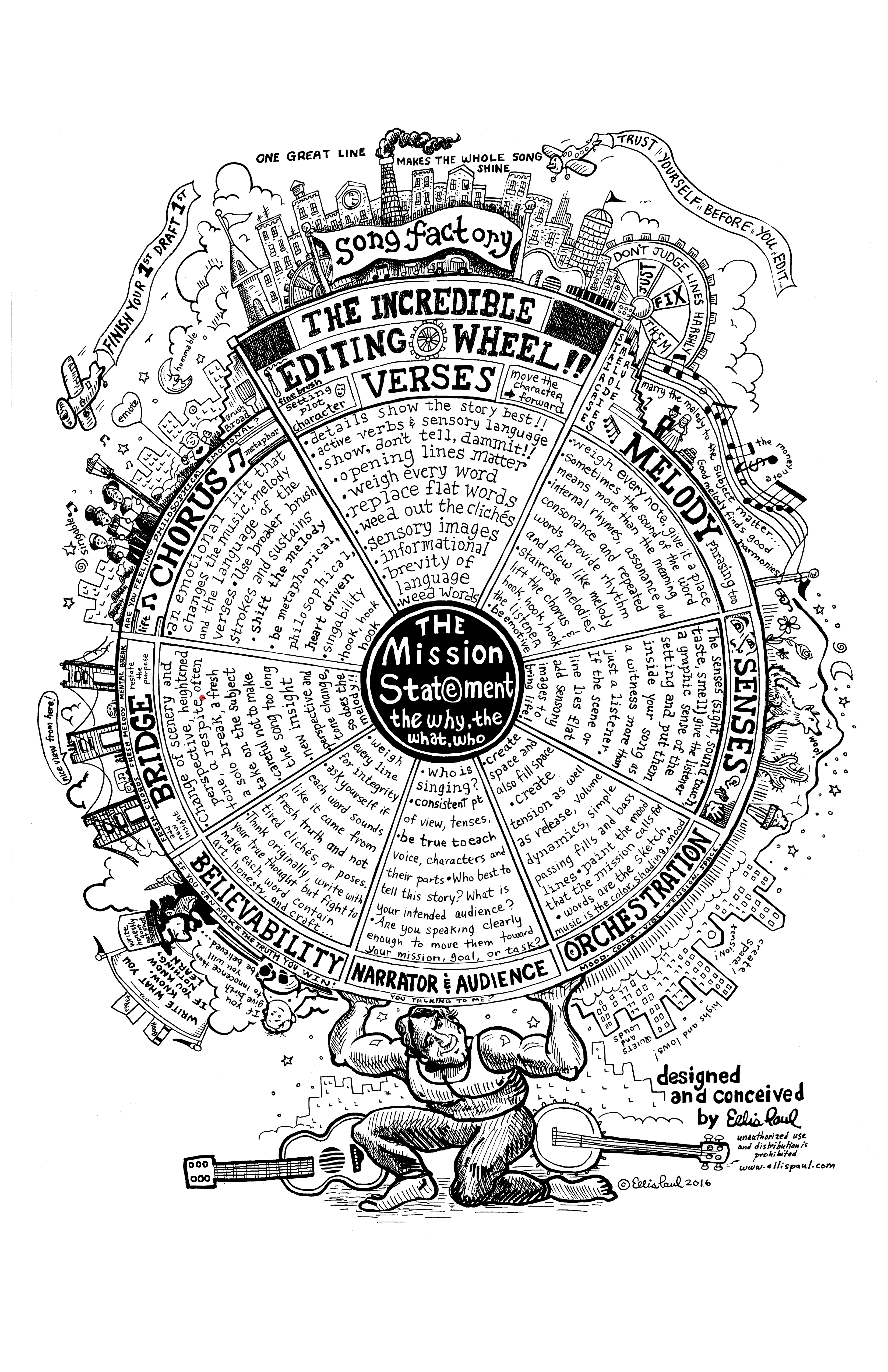
The Incredible Editing Wheel for Songwriters.
This was designed as an inspirational poster for people attending my songwriting workshops and retreats. It’s a visual representation of what I teach about editing, which is where a good song idea can really get crafted and become great.
I wanted people to go home with something they could put on the wall of their writing room that would remind them of ideas to apply to whatever song was currently in their pipeline.
The first thing you do, usually after the first draft is done, is to ask yourself what is the song about? Who is it for? Why is worth listening to?
Refine the idea, like a pitch for a movie. And then, you take that Mission Statement of the song through the various parts and sections of the poster and ask yourself: how is the Mission Statement partnering with what you say in the verses, the chorus, the orchestration, etc?
The Mission Statement should show you where you are failing the song, and it make your edits easier to recognize and fix. The straighter the flight of the song’s arrow, the more effective it is with an audience.
All the sections and parts of the song — from the idea to the melody — when filtered through a well-conceived Mission Statement, will make for a more powerful listening experience for your audience. This streamlines the editing process so you can improve the song quickly.
Below the image you’ll find the text from the poster. To purchase your own copy, to hang on your wall for instant inspiration, go here.


Crafting a great song from a good idea
Verses
Details show the story best!! Active verbs and sensory language. Show don’t tell, dammit! Opening lines matter! Weigh every word. Replace flat words. Weed out clichés. Use sensory images. Informational. Brevity of language. Weed words.
Chorus
An emotional lift that changes the music, melody, and the language of the verses. Use broader brush strokes and sustains. Shift the melody. Be metaphorical, philosophical, heart driven. Singability. Hook, hook, hook.
Bridge
Change of scenery and perspective, heightened tone, a respite, often a solo break, a fresh take on the subject. Careful not to make the song too long. New insight. Perspective and tone change, so does the melody.
Believability
Weigh every line for integrity. Ask yourself if each line comes from fresh truth and not tired clichés, or poses. Think originally. Write with your true thought but fight to make each word contain art, honesty, craft.
Narrator and Audience
Who is singing? Consistent point of view and tenses. Be true to each voice, characters and their parts. Who best to tell this story? What is the intended audience? Are you speaking clearly enough to move them toward your mission. Goal or task?
Orchestration
Create space and fill space. Create tension as well as release, volume dynamics, simple passing fills and baselines. Paint the mood that the mission calls for. Words are the sketch, music is the color, shading, mood.
The Senses
The senses (sight, sound, touch, taste, smell) give the listener a graphic sense of the setting and put them inside your song as a witness more than just a listener. If the scene lies flat, add sensory images to bring to life!
Melody (phrasing too)
Weigh every note. Give it a place. Sometimes the sound of the word means more than the meaning. Internal rhymes, assonance, and consonance and repeated words provide rhythm and flow like melody. Staircase melodies lift the chorus and hook, hook, hook the listener. Be emotive.